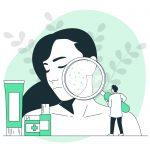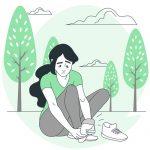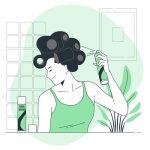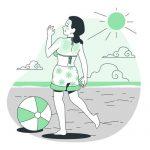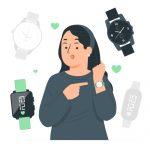
Warm-Up
Breast veins, also known as chest veins or thoracic veins, are a common condition where visible veins appear on the breast or chest area. This can happen to anyone, including men and women, but it is more prevalent in women due to hormonal changes. Breast veins can be caused by a variety of factors, including genetics, pregnancy, weight gain, aging, and hormonal changes. These veins can be blue, green, purple, or red, and may appear as small clusters or larger lines.
Interesting fact: Did you know that breast veins can also be a sign of breast cancer? While this is rare, it is important to get any changes in your breast veins checked out by a healthcare professional.
Although breast veins are usually not harmful, they can be a source of discomfort or self-consciousness for some people. Fortunately, there are several ways to prevent or treat breast veins, depending on the severity of the condition.In the next sections, we will explore the causes of breast veins in more detail and provide you with some practical tips on how to treat women breast veins. We’ll also share some fun and interesting facts along the way, so keep reading!
Causes of breast veins
Breast veins are a common condition that many women experience, and there are several causes of breast veins that women should be aware of. Here are the top five:
1. Hormonal changes:
Changes in estrogen levels during menstruation, pregnancy, or menopause can cause the veins in the breasts to dilate and become more visible.
2. Genetics:
Some women may have a genetic predisposition to develop breast veins. If your mother or grandmother had breast veins, you may be more likely to develop them as well.
3. Weight gain:
When a woman gains weight, the increased pressure on the veins can cause them to become more visible. This is especially true if the weight gain is in the breast area.
4. Age:
As we age, our skin and blood vessels lose elasticity, which can cause veins to become more visible.
5. Lifestyle factors:
Smoking, a sedentary lifestyle, and poor nutrition can all contribute to the development of breast veins. These factors can also increase the risk of other health conditions, such as cardiovascular disease.
Knowing the causes of breast veins is the first step in preventing and treating them. If you’re struggling with varicose veins on your breast, it’s important to seek advice on how to treat women breast veins effectively. Don’t hesitate to talk to your doctor about how to prevent or treat breast veins.
Treatment options: How can I get rid of breast veins?
Interesting fact: Did you know that breast veins can sometimes be mistaken for varicose veins? While they may look similar, varicose veins are swollen and twisted veins that are usually found in the legs and feet.
If you’re looking to treat breast veins, you have many options. Here are 5 potential treatments that may work for you:
1. Sclerotherapy:
Sclerotherapy was first introduced in the 1920s. This technique involves injecting a solution directly into the vein, causing it to collapse and eventually disappear. It’s a popular choice for women who are concerned about the appearance of breast veins.
2. Laser Therapy:
This treatment involves the use of lasers to destroy the blood vessel causing the breast vein. The laser heats up and closes off the vessel, causing it to be absorbed by the body. This option is often recommended for small and medium-sized veins.
Did you know that the laser technology was first used for medical purposes in the 1960s?
3. Radiofrequency Ablation:
This technique has been available since the early 2000s and it uses a small catheter to deliver heat energy directly to the vein and it. The heat then causes the vein to collapse and close off. Radiofrequency ablation is generally recommended for larger veins that are deeper under the skin.
4. Surgery:
In some cases, surgery may be the best option to treat breast veins. This may involve removing the affected vein or rerouting it so that it no longer causes visible veins. While surgery is often effective, it may involve a longer recovery time than other treatment options.
Did you know that the first breast vein surgery was performed in the late 1800s?
5. Compression stockings:
While compression stockings won’t eliminate breast veins entirely, they can help to reduce their appearance and prevent new ones from forming. These stockings provide graduated compression that helps to promote blood flow back to the heart. They’re also often recommended for people who have to stand for long periods of time, as they help to prevent varicose veins.
Did you know that the first compression stockings were invented in the 1950s?
No matter which treatment option you choose, be sure to talk to your doctor about which one is right for you. With the right treatment and care, you can say goodbye to breast veins and feel more confident in your skin!
How can I prevent breast veins?
Breast veins may seem like a minor issue, but it’s always better to prevent them from occurring in the first place. Here are five easy and effective ways to prevent breast veins from forming:
1. Maintain a healthy weight:
Obesity and being overweight can increase the pressure on the veins, which can lead to the development of breast veins. By maintaining a healthy weight, you can reduce this pressure and avoid developing this condition.
Fun fact: Did you know that an elephant’s heart weighs approximately 50 pounds?
2. Wear a well-fitted bra:
Wearing an ill-fitting bra can restrict blood flow and cause blood to pool, leading to the formation of breast veins. Make sure you’re wearing the right size and style of bra to avoid this.
3. Exercise regularly:
Regular exercise can help to improve blood flow, which can prevent the development of breast veins. Try incorporating low-impact exercises such as walking, swimming, or yoga into your routine to keep your veins healthy.
4. Stay hydrated:
Drinking plenty of water can help to keep your veins healthy and functioning properly. Aim for at least eight glasses of water a day to keep your body hydrated and your veins in good shape.
5. Elevate your legs:
Sitting or standing for extended periods of time can cause blood to pool in your veins, including those in your breasts. To prevent this, try to elevate your legs whenever you can, or take breaks to move around and get your blood flowing.
Fun fact: Did you know that a group of flamingos is called a flamboyance?
By following these prevention tips, you can avoid the discomfort and embarrassment of breast veins. However, if you do notice any signs of breast veins, such as pain or visible veins, make sure to consult a healthcare professional to determine the best course of treatment.
Ending Strong
Congratulations! You’ve made it to the end of our guide on how to get rid of breast veins. We hope that you found this post informative and helpful, and that you’re feeling empowered to take action against those pesky veins. Remember, prevention is key, so be sure to adopt healthy habits like staying active, eating a balanced diet, and wearing supportive bras. If you’re already dealing with breast veins, don’t worry – there are plenty of effective treatment options available, from laser therapy to sclerotherapy. Our team of experts and specialists at Yarabel are always here to help, so if you have any questions or concerns, don’t hesitate to reach out. Book a free consultation with us today by calling +1 (332) 333-1900 or emailing [email protected]. Let’s work together to help you achieve the smooth, beautiful breasts you deserve.









